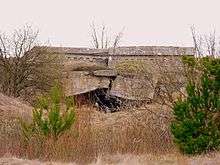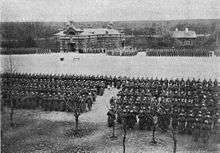Osowiec Fortress
Coordinates: 53°28′20″N 22°39′06″E / 53.47222°N 22.65167°E



Osowiec Fortress (Polish Twierdza Osowiec) is a 19th-century fortress located in north-eastern Poland, built by the Russian Empire. It saw heavy fighting during World War I when it was obstinately defended for several months by its Russian garrison against German attacks.
The fortress was built in the years 1882-1892 as one of the defensive works to protect the western borders of Russia against Germany, and continuously modernised afterwards to cope with advances in heavy siege artillery. In 1889-1893, military engineer Nestor Buinitsky took an important part in the creation of the fortress. It was located on the river Biebrza about 50 km from the border with the German province of East Prussia, in the one place where the marshlands of the river could be crossed, hence controlling a vital chokepoint. The extensive marshlands and bogs that surrounded it made attacks upon it difficult. The strategic Belostok - Lyck - Königsberg rail line also ran through the fortress and crossed the Biebrza river there. The fortress saw heavy fighting during the beginning of World War I in the eastern front from September 1914 until the Russian Army abandoned it in August 1915. In the interwar years the fortress was used by the Polish Army. During the German invasion of Poland in 1939 it was bypassed and did not see much fighting.
Today, some parts of the fortress are accessible to tourists, especially the parts within the boundaries of Biebrza National Park. The visitor information center of the park is located in Osowiec-Twierdza,[1] a small settlement located within the boundaries of the fortress. Other parts of the fortress still belong to the Polish Army and access is restricted.
1st German Assault - September 1914
In September 1914, the fortress was put under siege by parts of 8th German army - 40 infantry battalions that attacked immediately upon arriving. By 21 September, having a huge advantage in numbers, the Germans troops were able to push back Russian field defenses to the point where German artillery could fire upon the fortress itself. At the same time German command reinforced their forces with 60 artillery pieces of calibers up to 203mm; however, these pieces could only start firing on 26 September 1914. Two days afterwards the Germans decided to try a frontal assault of the fortress, but it was cut down by a fierce fire from Russian artillery. The next day the Russians made two flanking counter-attacks that forced the Germans to quickly relocate artillery to a safer place, although this put their guns too far from the fortress to fire on it.
2nd German Assault - February to March, 1915
On 3 February 1915, German forces attempted a 2nd assault on the fortress. A long and hard battle was fought for the control of 1st line of field defenses. The Russian forces were able to hold off numerically superior forces for 5 days in shallow trenches. On 9 February, Russian command decided to pull back all the forces to the 2nd field defense line that had deep trenches and established machine gun placements.
During the next two days, Russian forces gave no ground, but the retreat from the first line allowed German artillery to start firing on the forts on February 13. The caliber of German heavy siege artillery varied from 100 mm up to 420 mm. The cannons fired in groups of 360, and every four minutes 360 explosions rattled the fortress. Throughout the week-long artillery barrage, 250,000 shots were fired from the heavy guns and about one million rounds were fired from the light artillery pieces.
The Russian Central Command, thinking that they were asking the impossible, requested the fortress last at least 48 hours to allow the evacuation of civilians to be completed. The Osowiec Fortress lasted for half a year.
The Russians suffered heavy losses from the artillery barrage, which was strongest from 14 to 16 February and from 25 February to 5 March 1915. Multiple hits inside the fortress and the collapse of many buildings made movement between different parts of the fortress almost impossible. Even in these terrible conditions, the Russian artillery managed to destroy two out of the four heavy mortars and forced the German commanders to pull the remaining two back.
Because the 2nd Russian field defense line was never breached Germans were forced into positional warfare on this part of the front until the beginning of July.
3rd German Assault - July to August, 1915
| Attack of the Dead Men | |||||||
|---|---|---|---|---|---|---|---|
| Part of Eastern Front World War I | |||||||
| |||||||
| Belligerents | |||||||
|
|
| ||||||
| Commanders and leaders | |||||||
|
|
| ||||||
| Strength | |||||||
| 14 battalions | 60 - 100 men | ||||||
| Casualties and losses | |||||||
| Moderate | Heavy | ||||||
At the beginning of July, under the command of Field-Marshal Paul von Hindenburg, German forces began a full frontal offensive on the fortress. Forces included 14 battalions of infantry, one battalion of sappers, 24-30 heavy siege guns, and 30 batteries of artillery equipped with poison gases. The Russian defenders had 500 soldiers of the 226 Zemlyanski division and 400 militia men.
Gas attack
The Germans waited until 6 August for the right wind conditions. At 4 a.m., at the same time that the regular artillery started its bombardment, German forces used chlorine gas against the defenders.[2] Thinking that all of the defenders were dead, fourteen battalions of Landwehr (at least 7,000 infantry men) began advancing. When German infantry reached the first line of defense, they encountered what was left of 13th company of the 226th Zemlyansk regiment (about 60–100 men). Being unprepared for resistance and seeing the bloody clothing that the remaining defenders wore – Russian soldiers were coughing up blood because of the effects of the chlorine gas – the Germans were shocked; they broke and ran. The five remaining Russian guns subsequently opened fire on the fleeing Germans. This incident has been called "the Attack of the Dead Men".[3]
Fifteen days later, Russian commanders finally withdrew the last remaining soldiers from Osowiec and retreated to new positions.
After World War I
During the existence of the Second Polish Republic during the interwar period, some of the buildings of the fortress were refurbished and housed several Polish army units, among them the Central School of Non-Commissioned Officers of the Border Protection Corps. The fortress did not see action during the September campaign, but the 135th Reserve Infantry Regiment was formed from the school after the invasion of Poland began. After the fortress was abandoned by Polish soldiers on 13 September, it was occupied by German troops, but was handed over to Soviet troops from the 20th Motor Rifle and Machine Gun Brigade on 25 September. The fortress later served as a barracks for troops of the 10th Army, and was reoccupied by German troops on 27 June 1941 after the German invasion of the Soviet Union began on 22 June. During the occupation, it housed an ammunition warehouse, among other functions. On 14 August 1944 three of the forts were stormed by troops from the 49th Army and the 50th Army during the Osovets Offensive, but Fort II remained in German hands until January 1945, when it was abandoned during the Vistula–Oder Offensive. In 1953 the fortress was regarrisoned by a Polish Air Force ammunition depot,[4] which was absorbed into the 11th Regional Materiel Base in 1998.[5] In 2011, the Osowiec garrison became part of the 2nd Regional Logistics Base.[6]
References
- ↑ Lonely Planet guidebook Poland
- ↑ Regarding the gas attack of the 6 August 1915, historians' accounts conflict in some details. Chlorine gas was used according to some authors (Kauffman & Kauffman, 2016 ; Buttar, 2017), whereas a mixture of chlorine and bromine was used according to other authors (Cherkasov et al., 2011 ; Khmelkov, 1939). The gas was contained in artillery shells according to one source (Kauffman & Kauffman, 2016), whereas the gas was contained in cylinders according to other sources (Buttar, 2017 ; Cherkasov et al., 2011 ; Khmelkov, 1939).
- ↑ See:
- Petrone, Karen (2015). "7. 'Now Russia returns its history to itself ': Russia celebrates the centenary of the First World War". In Ziino, Bart. Remembering the First World War. London, England: Routledge. p. 135.
- Kauffman, J.E.; Kauffman, H.W. (2016). Verdun 1916: The Renaissance of the Fortress. Barnsley, England: Pen and Sword. pp. 112–113. See also p. 225, endnote 46.
- Buttar, Prit (2017). Germany Ascendant: The Eastern Front 1915. Oxford, England: Osprey Publishing. p. 318.
- Cherkasov, Alexander А.; Ryabtsev, Alexander А.; Menjkovsky, Vyacheslav I. (15 December 2011). "«Dead Men Attack» (Osovets, 1915): Archive Sources Approach" (PDF). European Researcher, series A. 2 (12): 1577–1582. Available at: European Researcher (Sochi, Russian Federation)
- ↑ "Historia Twierdzy Osowiec". szuwarygoniadz.pl (in Polish). Retrieved 2017-06-08.
- ↑ "11 RBM - 11 Rejonowa Baza Materiałowa Olsztyn". 2009-05-11. Archived from the original on 2009-05-11. Retrieved 2017-06-08.
- ↑ "RYS HISTORYCZNY". 2rblog.wp.mil.pl (in Polish). Retrieved 2017-06-08.
Bibliography
- Хмельков С. А. (Khmelkov, S.A.) (1939). Борьба за Осовец (Struggle for Osovets) (in Russian). Moscow: Государственное военное издательство наркомата обороны СССР.
- Perzyk Bogusław (2004). Twierdza Osowiec 1882 - 1915 (in Polish). Warszawa: Militaria Bogusława Perzyka. ISBN 83-907405-1-6.